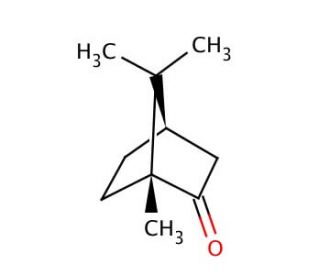
Click on image or enlarge button to enlarge

(1R)-(+)-Camphor: sc-251645
(1R)-(+)-Camphor (CAS 464-49-3)
Alternate Names:
(+)-Camphor; (1R)-1,7,7-Trimethylbicyclo[2.2.1]heptan-2-one
CAS Number:
464-49-3
Purity:
≥98%
Molecular Weight:
152.23
Molecular Formula:
C10H16O
Supplemental Information:
This is classified as a Dangerous Good for transport and may be subject to additional shipping charges.
For Research Use Only. Not Intended for Diagnostic or Therapeutic Use.
* Refer to Certificate of Analysis for lot specific data (including water content).
QUICK LINKS
Ordering Information
Description
Technical Information
Safety Information
SDS & Certificate of Analysis
Camphor, a naturally occurring organic compound, has found its place indiverse products over the centuries. This white crystalline substance, emanating a potent and aromatic fragrance, originates from the wood of the camphor tree (Cinnamomum camphora). With its multi-faceted properties, camphor serves as an insect repellent and a key element in items like soaps, cosmetics, and candles. Moreover, the scientific realm has begun to harness camphor′s distinct chemical and biological characteristics, elevating its significance in research endeavors. This discourse delves into the methodology of synthesis, the realm of scientific research applications, the intricate mechanism of action, the extent of biological influence, along with biochemical and physiological repercussions. Yet, the precise mechanism by which camphor operates remains partially veiled. Present hypotheses suggest its interaction with a medley of receptors and enzymes within the body, precipitating an array of biological responses. Moreover, camphor′s interplay with diverse enzymes, including the pivotal cytochrome P450 enzymes accountable for drug and compound metabolism, stands as another facet of its intricate functioning.
References:
- The desymmetrization of bicyclic beta -diketones by an enzymatic retro-Claisen reaction. A new reaction of the crotonase superfamily. | Grogan, G., et al. 2001. J Biol Chem. 276: 12565-72. PMID: 11278926
- Stereoselective hydrocoupling of [(1R)-exo]-3-exo-(diphenylmethyl)bornyl cinnamates by electroreduction. | Kise, N., et al. 2001. Org Lett. 3: 3241-4. PMID: 11594804
- A Highly diastereoselective synthesis of (1R)-(+)-camphor-based chiral allenes and their asymmetric hydroboration-oxidation reactions. | Hung, SC., et al. 2002. J Org Chem. 67: 1308-13. PMID: 11846679
- Chiral tricyclic iminolactone derived from (1R)-(+)-camphor as a glycine equivalent for the asymmetric synthesis of alpha-amino acids. | Xu, PF., et al. 2002. J Org Chem. 67: 2309-14. PMID: 11925246
- P450(camr), a cytochrome P450 catalysing the stereospecific 6- endo-hydroxylation of (1 R)-(+)-camphor. | Grogan, G., et al. 2002. Appl Microbiol Biotechnol. 59: 449-54. PMID: 12172608
- Synthesis and characterization of camphorsulfonyl acetate of cellulose. | Xiao, D., et al. 2004. Carbohydr Res. 339: 1925-31. PMID: 15261585
- Cytochrome P450cam-monoterpene interactions. | Van Roon, A., et al. 2005. SAR QSAR Environ Res. 16: 369-84. PMID: 16234177
- Alternative synthetic route to chiral N-substituted camphor-derived beta-amino alcohols. | Cheng, GI., et al. 2007. Chirality. 19: 235-8. PMID: 17230497
- Toxicity of Myristica fagrans seed compounds against Blattella germanica (Dictyoptera: Blattellidae). | Jung, WC., et al. 2007. J Med Entomol. 44: 524-9. PMID: 17547241
- Electron ionization mass spectral studies of bridgehead-substituted norbornan-2-ones: camphor derivatives. | Teso Vilar, E., et al. 2011. Rapid Commun Mass Spectrom. 25: 395-409. PMID: 21254275
- Identification of camphor oxidation and reduction products in Pseudomonas putida: new activity of the cytochrome P450cam system. | Prasad, B., et al. 2011. J Chem Ecol. 37: 657-67. PMID: 21562741
- The use of deuterated camphor as a substrate in (1)H ENDOR studies of hydroxylation by cryoreduced oxy P450cam provides new evidence of the involvement of compound I. | Davydov, R., et al. 2013. Biochemistry. 52: 667-71. PMID: 23215047
- Modeling the Solubility of Monoterpenoids with Hybrid and Predictive Thermodynamic Tools. | Vilas-Boas, SM., et al. 2023. Ind Eng Chem Res. 62: 5326-5335. PMID: 37014371
- Structural changes in cytochrome P-450cam effected by the binding of the enantiomers (1R)-camphor and (1S)-camphor. | Schulze, H., et al. 1996. Biochemistry. 35: 14127-38. PMID: 8916898
Ordering Information
| Product Name | Catalog # | UNIT | Price | Qty | FAVORITES | |
(1R)-(+)-Camphor, 5 g | sc-251645 | 5 g | $30.00 |